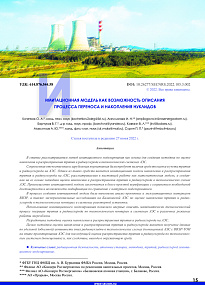Simulation model as a possibility of describing the process of transfer and accumulation of nuclides.
Kochetkov O. A., Anpilogova I. N., Barchukov V. G., Kovyazin V. L., Maksimov A. Yu., Surin P. P.
The article considers the method of simulation modeling as a basis for development of a methodology on accounting accumulation and distribution of tritium and radiocarbon in the technological systems of NPPs.
The modern domestic and foreign regulatory frameworks require the availability of tritium and radiocarbon accounting tools at nuclear power plants. One of these tools is a simulation model of the accumulation and distribution of tritium and radiocarbon at nuclear power plants and a technique based on it. The advantage of the simulation model is that it is easier to verify, while maintaining the necessary reliability and the possibility of modification, compared to full-scale modeling.
The use of simulation modeling made it possible for the first time to describe mathematically the technological process of tritium and radiocarbon migration along technological circuits and systems of NPPs in various operating modes of the power unit.
The purpose of the technique for assessing the accumulation and distribution of tritium and radiocarbon is to obtain data on the specific activity of these radionuclides in technological schemes of NPPs with VVER TOI at the design stage of the NPP for the subsequent assessment of the distribution through technological systems, and consequently, release to the environment.
Keywords: radiation safety, nuclear power plants, methodology, tritium, radiocarbon, simulation.
Article language: Russian. Pp. 15–27. DOI: 10.26277/SECNRS.2022.105.3.002.
Simulation model as a possibility of describing the process of transfer and accumulation of nuclides
Authors:
Kochetkov O. A. , Anpilogova I. N. , Barchukov V. G. , Kovyazin V. L. , Maksimov A. Yu. , Surin P. P.
Issue:
3 (105) – 2022.


